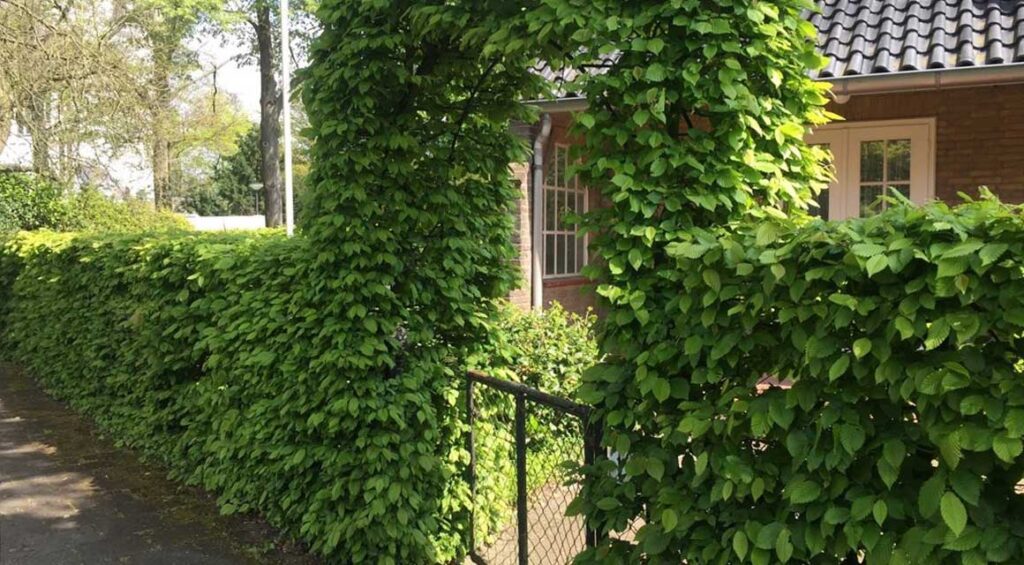How to choose hedge plants to combine?
When choosing different hedge plants to plant next to each other, we usually look at the overall effect the plants will have next to each other. Some plants go well together others look very similar and therefore go well together. For example, we pay close attention to the flowering time of our flowering hedges, so that the plants either all bloom at the same time or one after the other, so that there is something beautiful to see in your garden for a long time. It is of course important that the hedge looks pretty in the end.
It is of course also practical to use plants that reach approximately the same height. Some of our mixed hedges are divided into high and low hedges, so you know in advance whether your mixed flower hedge can reach 4 meters high or only 1.5 meters. Even in the hedge packages where this is not explicitly mentioned, we have made sure that low and high hedge plants are not combined. If you want to make your own plant combination, this is an important feature to pay attention to. Taking different varieties of one plant, as with our mixed butterfly bush hedge, can work well.
Also, location is important. In theory, two plants can look great together, but if they can’t grow in the same place they won’t make a nice hedge. The hornbeam and beech hedge have many similar characteristics that would make them a good combination. However, they both have different soil preferences, so one plant may thrive better in the same place than the other. Soil type and light penetration are always important factors when choosing a location for a hedge.

Contents
Evergreen and deciduous, is it good?
It is certainly not impossible to find hedge plants that meet the above characteristics. For example, a little-leaved linden grows in almost any soil and can reach meters in height. As long as the littleleaf linden is not in the shade, this plant has no difficulties. So, theoretically, it can be easily combined with various species of cherry laurel that can also grow in most types of soil. Whether the combination of the two plants will be a success remains to be seen, because the cherry laurel and the littleleaf linden have a rather different appearance.
The most important question is also what happens in winter. A combined hedge of deciduous and evergreen hedge plants can give you a bit more privacy in your garden than just a deciduous hedge, while still being nice to look at during the different seasons in your garden. On the other hand, it can also quickly look like your evergreen hedge is not quite healthy and has lost its leaves. Therefore, at Hedgeplantsdirekt.com we have decided not to create mixed hedge packages with evergreen and deciduous hedges.
Are there ways to combine deciduous and evergreen plants?
Of course, deciduous and evergreen plants can be combined very well without having to plant them alternately in a hedge. One way to create a garden partition that is part evergreen and part deciduous is to use espaliered trees. For example, use a hornbeam or copper beech as the screening deciduous part of the hedge and plant a low evergreen hedge of cherry laurel or yew underneath. When your trellis trees lose their leaves in winter the low hedge will still be nice and green without the combination looking odd.
You can also use different hedges in different places. A garden partition made of yew or another conifer provide a lot of privacy. There is nothing wrong with adding an informal hedge of, for example, butterfly bush or yellowwood dogwood to a patio or bed, so you can add some extra color and variety to the garden. Many of our hedge plants are also great as specimen plants or in clumps. For example, the hydrangea or the rhododendron. Planting evergreens and deciduous hedge plants close together often works better than alternating them within a hedge.
The design of a garden
Which plants you choose for your garden depends, of course, entirely on your personal taste. We have already given you a few tips at the beginning of this blog on the composition of mixed hedges, which you can of course apply to the selection of the rest of the garden plants. Designing a garden is a creative process in which you can’t do anything “wrong”. The most important thing is to choose plants that will do well in your garden. This can be related to soil type, light, polluted air, or even sea salt.
Want to know if certain plants go well together? Look at photos of both plants in all seasons. For expert advice you can also contact our customer service. We do our best to help all our customers and use our experience with hedge plants to beautify your garden.

